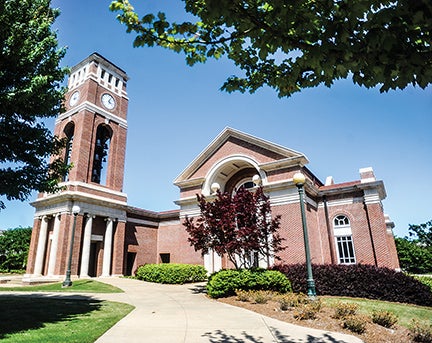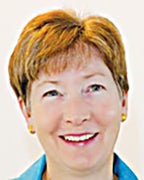The Paris-Yates Chapel welcomes all
Published 12:00 pm Friday, May 13, 2016

- Bruce Newman Bruce Newman Paris-Yates Chapel on the Ole Miss campus hosted the first Shabbat service for the Jewish Federation of Oxford last week.
My first visit to the Paris-Yates Chapel was at dusk about 10 years ago.
As I stood looking at the stained-glass window located above the entrance to the chapel, the lights inside the chapel highlighted the window and it looked strikingly beautiful. I noticed that the design was the Star of David and a cross intertwined, and it fascinated me, as I had never seen anything like that before. Over the years I have attended many events at the chapel, from concerts to talks on religion to a memorial service. I always feel at peace in the chapel and admire the simple beauty of the place.
Just recently through a connection with Thacker Mountain Radio friends, Mary Lou and Snooky Williams, I was able to meet Henry Paris, one of the men who helped to make the chapel a reality.
As I sat on the couch at the Paris’ home I noticed a coat of arms prominently displayed beside their fireplace showing the cross and the Star of David, the same symbol featured in the stained glass window of the Chapel.
Paris told me that he was Jewish and his wife, Rose, was Presbyterian. They have been married for 62 years and although they have disagreed over many things, they have never argued over religion.
They met at Ole Miss where Henry was a cheerleader, had been elected as Colonel Rebel, and placed in the University Hall of Fame. Henry joined a small Jewish fraternity, as other fraternities did not accept Jews at that time. Despite that, he went on to tell me that he loved Ole Miss and never felt a moment of discrimination or prejudice because he was of the Jewish faith.
Where to get married?
When Rose and Henry decided to get married they ran into problems, as neither the Presbyterian Church nor a rabbi would marry them. So they got married in Rose’s sorority house, Delta Gamma, where a Presbyterian minister performed the ceremony.
Their difficulty in finding a place to get married planted the seeds in their minds for the need for an interdenominational chapel, although it was to be many years before this idea came to fruition.
In 1976, a committee was formed and $30,000 was raised, but unfortunately the project did not proceed at that time.
Fast-forward two decades to when Robert Khayat became chancellor of the University. One of Khayat’s primary goals was to have a chapel built on campus. At the same time Henry Paris and his son Lee, along with J. Stacy Davidson Jr., approached Robert Khayat about resurrecting the earlier plans to build a chapel.
Vision for a window
Henry and Rose Paris were willing to contribute the lead gift to build the chapel, and they visualized a beautiful stained glass window featuring the Star of David and a cross to symbolize not only their union, but also the fact that the chapel would be interdenominational. However, the design of the stained-glass window raised a potential problem. The university explained that there was an issue with religious symbols being used on public property due to the First Amendment separating church and state.
Lee and Henry Paris took the matter to the American Civil Liberties Union in Jackson. The ACLU lawyer cited an example of how religious symbols could be used if they were incorporated in a family crest. Since the Paris family had adopted the symbol as their family crest, the committee approved its use in the stained glass window.
Robert Khayat formed a committee to oversee the project. Lee Paris, as committee co-chair, worked tirelessly to raise the necessary funds. The chapel cost $3.8 million and was built by contributions that came in through the University of Mississippi Foundation (headed by Don Frugé), not by taxpayer dollars.
Working together
Many individuals worked hard to make the chapel the unique place it is now. The Paris family gave the lead gift including the stained-glass window, which was designed by an architectural firm in Jackson, and it is one of a kind. Bill Yates, who owned W.G. Yates & Sons Construction Company of Philadelphia, made an equally large contribution by donating his time and materials to build the chapel. Frank and Marge Peddle gifted the bell tower and its carillon composed of 36 bells that were made in Holland. Lee Paris and Robert Khayat were involved in the chapel from its inception to its completion, and provided invaluable input and leadership.
At the opening ceremony on April 28, 2001, people from every denomination on campus were invited to the event. Don Frugé’s wife, Mary Ann Frugé, asked people to sum up in one word what the chapel would mean to them. The group then joined hands as the Mississippi concert singers sang, “What a Wonderful World.”
Robert Khayat was responsible for naming the chapel Paris-Yates. Neither Henry Paris nor Bill Yates expected or asked for the chapel to be named after them. Since the chapel opened, 800 marriages have taken place there including two of the Paris’ granddaughters.
The people who envisioned the chapel, and gave their time and money to make it a reality were true visionaries.
The Paris-Yates Chapel opens its doors to everyone, and welcomes all who care to enter.
Joanne Wilkinson is an Oxford resident and can be reached at
jwilkinson1487@gmail.com.






